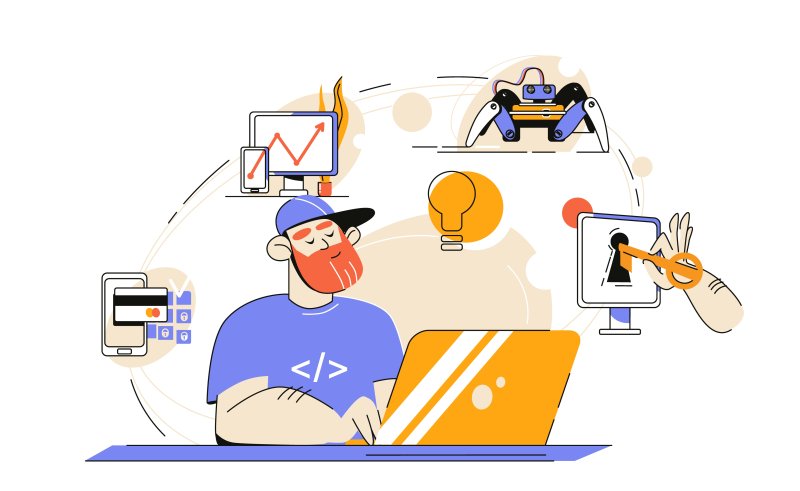
What is back-end development and what does a back-end developer do?
The backend is the backbone of any software. The backend is an invisible part of the project, and is responsible for the functionality of the software.
Those who developed software for their business earlier already understand the difference between back-end and front-end development. For those who encounter these concepts for the first time, this article will help to understand the intricacies of the process of IT solutions development, and not to have difficulty in contact with such terminology.
What is a back-end in simple words?
The backend is a part of the code, which is hidden from the user and is located on the server side. The code written on the backend handles user requests, and is responsible for implementing the software's internal workflows.
To keep it simple, let's take the simplest product within software development - website development.
Using the example of website development, the front-end part - is the functionality that is responsible for interaction with the user (ie, the interface, where the client sees the information and can carry out some actions: read the information, go to the page, leave a request or place an order).
And the back-end part - the code that processes these requests and creates the ability to move between pages, perform various actions and scenarios, checkout, making payments, and so on.
The moment a user places an order on the frontend, choosing various methods of delivery and payment, the backend at that moment processes requests on the server, searches for the necessary information in the database, stores new data, and, most importantly, correctly interacts all the functionality with each other.
What does a back-end developer do and which projects have a backend developer?
The key and only task of a backend developer is to create an invisible infrastructure, which is responsible for the operability of any project.
Every software development project has a backend developer. He writes the lion's share of the code that becomes the foundation of any product: the website, marketplace, CRM, ERP, LMS, personal account etc.
Everything that hides behind the beautiful form, buttons, features for the end user of the product - it must work, and it must work correctly. This is the task of the backend developer.
In addition to the implementation of all necessary software functionality and configuration of correct work with the database, the tasks of the backend developer also include the setup of various possible integrations with external services (courier delivery services, mail server and sip-telephony, payment systems, financial accounting and accounting systems, etc.).
The tasks of the backend programmer also include building of the frontend and backend and bug fixes (fixing bugs that arise during the build and testing of the finished software).
What kind of projects need a backend developer?
All types.
On simple projects, such as developing a corporate site or a simple online store, maybe one or two backend developers would be enough.
On larger projects, it is possible to involve teams consisting of a large number of backend developers who work to a clear TOR for their part of the functionality, allowing you to launch large-scale projects in a short time, ensuring a high level of quality of the developed software.
There are a large number of programming languages in which backend programmers write. Each programming language has its own advantages and disadvantages for different types of projects.
Therefore, when choosing a development team, pay attention to the technology stack they are dealing with and the matching of their expertise to the tasks that need to be solved for your business.

Learn more about the peculiarities of back-end development and why a good backend specialist is worth as the gold.
To understand what a backend programmer does, his tasks can be divided into three parts:
- database;
- server environment;
- API (Interfaces for Interaction and Integration).
1. The database is the place where all of the project's information is stored.
In the example of the online store, the database stores all the information about products (cost, availability, descriptions, etc.), data about available payment and delivery methods, user data, etc.
The database itself does not do anything, it only stores and overwrites information in the case of any actions and the implementation of the intended scenarios.
The request to the database is made through the server part. And so we gradually came to work with the server.
2. The server part.
Every software has two sides - the Server side and the Client side. The client side is the shell, with which the user interacts (whether user of the site, the CRM/ERP system user, the user of the personal account and so on). When the client part interacts with the interface, a request is sent to the server, and the server already processes this information.
For example, when you buy a product in the online store and make a payment, at this moment the backend level sends a request to the server, the server processes this request and gives you a response on this request (success or failure of the transaction, success or failure to complete the order).
At this stage, the server also accesses the database we mentioned above.
3. Setting up APIs (or Application Programming Interfaces).
On commercial projects it is often necessary to integrate external software: payment systems, mail servers, CRM, courier services, card APIs, LMS-systems, etc.
All these interactions and integrations are set up by the backend developer in accordance with the approved requirements specification for the project.
IC Studio backend development services
IC Studio team provides software development services from scratch and turnkey (where a team of professionals develops IT solutions for your business).
However if you have your own team of front-end developers, and you need to supplement it with back-end developers, we can consider this option of cooperation.
The main stages of development in this case will be:
1. Development of the requirements specification, which will form the basis of a new software.
As it is probably clear from what has been said above, the backend development is a complex issue which requires a high level of accuracy and understanding of how the system should handle user requests and how all the integrations work smoothly together.
That is why a well-thought-out requirements specification is 30-50% of success for any software.
Let us compare software development with the construction of a bridge or a building.
You can't build a bridge or a building without design, at which stage everything will be thought out in detail. Otherwise, that bridge/building won't be safe, and won't do the job it was built for.
2. Choose the right technology stack for a particular type of project.
As we wrote above, there are many development technologies that solve different problems in different ways. And our task is to determine which technology stack will allow you to implement your project in the best way, quickly enough, and with a high level of quality.
3. Database and architecture design.
At this stage we think through the architecture of the database, the entities, the relationships between the entities. The purpose of this stage is the qualitative interaction of all the components of the new software.
4. Implementation of the software logic.
Creating the backend, creating an admin panel where needed, configuring the API integrations. On this stage we create the scenarios of interaction between the Client and the Server, and implementation of the conceived logic of the software.
5. Testing, optimization and launching into production.
As a result of the development phase, we thoroughly test the finished product, checking it for compliance with the requirements specification. After making sure that the product complies with the requirements specification, we pass it to the customer in production.
These stages are key if you only order back-end development separately.
However, if you have your own resources to implement some of the tasks, we can also consider this option.
Contact us to discuss your project and find the formula of cooperation, which will result in the project being implemented with the required level of quality within the time frame you require. And we will be glad to consult you on any questions related to software development and backend development.